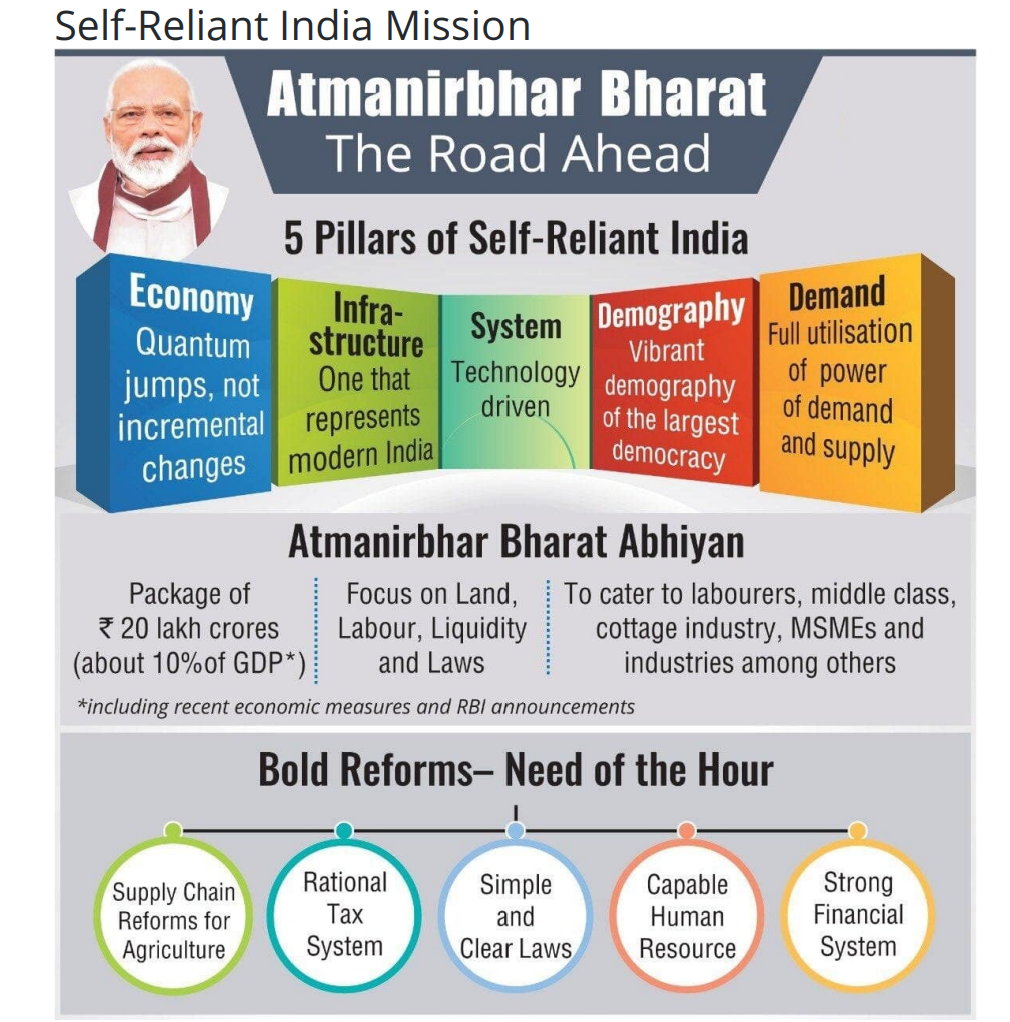India’s Self-Reliant (Atmanirbhar Bharat) Mission: A Global Perspective
The Self-Reliant India Mission is driven by the vision of reducing import dependence, primarily through substitution, while enhancing safety standards and the quality of goods to expand our presence in the global market. It’s a mission that embodies cooperation rather than exclusion or isolationism.
One of the mission’s fundamental principles is the promotion of local products. It unfolds in two phases:
Phase 1: This phase focuses on sectors like medical textiles, electronics, plastics, and toys, where local manufacturing and exports can be boosted.
Phase 2: In this stage, attention shifts to products such as gems and jewellery, pharmaceuticals, and steel, among others.
The mission is founded on five core pillars:
- Economy
- Infrastructure
- System
- Vibrant Demography
- Demand
This mission complements the ‘Make In India Initiative,’ which strives to foster manufacturing within India.
A Critical Look at the Declared Economic Package
The declared economic package has raised specific concerns due to including the Reserve Bank of India’s (RBI) expenditures within the government’s “fiscal” package. It’s worth noting that fiscal policy is under the government’s jurisdiction, while the RBI governs monetary policy. Therefore, combining these two entities’ expenditures isn’t a globally accepted practice.
For instance, when the United States announced a relief package of $3 trillion (approximately Rs 225 lakh crore), it exclusively referred to the government’s expenditure. It did not encompass the Federal Reserve’s actions.
Including RBI’s liquidity decisions in the calculation could significantly lower government spending. RBI has been conducting Long Term Repo Operations (LTRO) to infuse liquidity into the banking system. If another LTRO worth Rs 1 lakh crore is launched by the RBI, the overall fiscal support will decrease by that same amount.
Direct government spending usually includes initiatives like wage subsidies, direct benefit transfers, and salary payments, which promptly stimulate the economy by reaching the people through salaries or purchases. In contrast, measures taken by the RBI, such as credit easing to make more funds available to banks, may not guarantee immediate circulation into the broader economy. Banks may choose to park these funds with the RBI instead of lending them, which affects the natural stimulus to the economy.
In essence, while the declared amount is 10% of GDP, the actual cash outflow may be considerably less than 5% of GDP.

India’s Dual Narrative: A Tale of GDP and Per Capita Income
India’s economic journey presents an intriguing narrative. We’ve achieved remarkable milestones, surpassing the economies of the UK and France, with Germany and Japan well within reach over the next five years. The giants of America and China are the only ones left on the horizon. However, there’s a less impressive story beneath this GDP success – our per capita GDP lags significantly. Once on par with countries like Korea (in 1960) and China (in 1997), we now find ourselves trailing behind 138 nations.
The COVID-19 lockdown has laid bare the vital importance of per capita GDP for our citizens. It’s not just about the overall economic size; it’s about ensuring the well-being and prosperity of each individual.
So, why does India excel in political empowerment, breaking through the barriers of a deeply hierarchical society, while economic empowerment remains a complex challenge? A recent enlightening book, “Gandhi: The Years that Changed India” by Ramachandra Guha, offers a perspective. It suggests that Gandhi, unlike other freedom fighters, redefined “Swaraj” to mean not just national independence but “Swa-Raj” or self-rule. While our political Swaraj has seen successes, individual economic Swa-Raj has been elusive.
The hurdles lie in the domains of formalization, industrialization, urbanization, financialization, and skilling. The Atmanirbhar Bharat Abhiyaan (ANBA) policies, announced in response to the economic challenges posed by COVID-19, are steps toward fulfilling Gandhiji’s vision of individual self-reliance and recognizing poverty as a form of violence.
These policies not only address the economic impact of the pandemic but also signify our commitment to empowering individuals economically, in alignment with our rich legacy of political Swaraj. The goal is to bridge the divide between our impressive GDP numbers and the economic well-being of every Indian citizen.
Understanding Low Caloric Intake and the Need for a Nuanced Approach:
- Low calorie intake doesn’t always indicate nutritional deficiency. Various factors can contribute to reduced calorie consumption, including decreased physical activity, increased reliance on home appliances, and the impact of physical health conditions on dietary choices.
- Applying a uniform calorie norm to a diverse and vast country like India may not be justifiable. India’s population comprises a wide range of dietary preferences, lifestyles, and regional variations, making a one-size-fits-all approach impractical.
- Accurate measurement of undernourishment requires scientific assessments, including weight and height measurements. However, the methodology employed in this context relies on a Gallup poll, which primarily involves telephonic estimates. Such an approach may not provide a comprehensive understanding of the nutritional status of the population.
- The report appears to overlook the extensive efforts made by the government to ensure food security during the COVID-19 pandemic. Initiatives such as the Pradhan Mantri Garib Kalyan Anna Yojna (PMGKAY) and the Atmanirbhar Bharat Scheme (ANBS) were implemented to support the entire population’s nutritional needs during challenging times.
The Interlinking of Atmanirbhar Bharat Abhiyan and Swaraj
The concept of Atmanirbhar Bharat Abhiyan (Self-Reliant India Campaign) is deeply intertwined with the ideals of Swaraj, as envisioned by
Mahatma Gandhi. Swaraj, in the understanding of Gandhi, holds multifaceted meanings and is profoundly linked to India’s quest for self-reliance. Here’s an exploration of the connection between Atmanirbhar Bharat Abhiyan and the principles of Swaraj:
1. Political Swaraj:
- For Gandhi, Swaraj encompassed political self-government, emphasizing that good government alone was not a substitute for self-government. It entailed a relentless endeavour to free oneself from government control, be it foreign or domestic. Swaraj, in political terms, implied the sovereignty of the people, rooted in moral authority rather than external domination.
2. Economic Swaraj:
- Poorna Swaraj, according to Gandhi, meant achieving total economic freedom for the masses. It signified eliminating poverty, hunger, lack, deprivation, and exploitation. Economically, Swaraj aimed to eradicate the divide between exploiters and the impoverished, thereby ensuring the unprivileged could enjoy freedom from the burdens of scarcity and poverty. It emphasized material prosperity alongside intellectual growth, moral development, physical well-being, and social elevation.
3. Individual Swaraj:
- At the individual level, Swaraj is involved in self-assessment and self-purification, signifying the introspective and ethical dimensions of personal development.
4. Holistic Swaraj:
- In its most profound sense, Swaraj transcended mere freedom from external constraints. It epitomized self-rule and self-restraint, akin to moksha or salvation. It was the pursuit of comprehensive self-realization and self-governance.
The Atmanirbhar Bharat Abhiyan aligns with Gandhiji’s vision of individual self-reliance and acknowledges that poverty is a form of violence that hinders true Swaraj.
Assessing Economic Swaraj:
India’s economic trajectory is noteworthy, but the per capita GDP presents a contrasting picture. Several factors impede India’s path towards self-reliance:
- Regulatory Cholesterol: Excessive regulatory burdens hinder economic prosperity, although recent efforts have been made to alleviate these constraints.
- Low Productivity: Indian cities lag behind global economic hubs regarding productivity. Enhancing urban productivity is a crucial step.
- Missed Manufacturing Opportunities: India missed the manufacturing export boom that China experienced. However, there may still be opportunities on the horizon.
Striving for Economic Swaraj: Have We Attained It?
The question of whether India has achieved economic Swaraj is a pertinent one. While India’s GDP growth story is undoubtedly fascinating, there are critical nuances to consider, especially in the context of per capita GDP. The assessment reveals that while India’s economic journey is intriguing, it still has a long way to go before achieving Swa-Raj.
- GDP Growth Story: India has witnessed commendable GDP growth in recent years, positioning itself as one of the world’s fastest-growing economies. However, this broad success story conceals underlying challenges.
- Per Capita GDP Discrepancy: The real issue lies in per capita GDP, where India lags. While the overall economic growth is remarkable, the wealth generated has not been distributed equitably among the population, resulting in a significant gap in the living standards of citizens.
- Barriers to Economic Swaraj: Several factors contribute to the existing disparity. Inadequate formalization of the economy, limited industrialization, slow urbanization, insufficient financial inclusion, and gaps in skill development all play a role in hindering the realization of Swa-Raj.
- Unleashing the Potential: To achieve economic Swaraj, India must address these challenges. This includes promoting formalization, boosting industrial growth, accelerating urban development, strengthening financial inclusion, and fostering skill development.
- Global Economic Participation: As a critical player in the global economy, India’s progress is vital not only for its citizens but also for global economic stability and growth. Achieving economic Swaraj would signify a more balanced and equitable distribution of wealth, improving the quality of life for all.
In conclusion, while India’s economic story is captivating, it is crucial to recognize the areas where progress is yet to be made. Striving for economic Swaraj means addressing the disparities in per capita GDP and ensuring that the benefits of growth reach every citizen. This pursuit is not only a national imperative but also an essential element of global economic progress.
Identifying the Shortcomings in India’s Economic Agenda for Self-Reliance
When it comes to achieving self-reliance, there are several critical lapses in India’s economic agenda that need to be addressed:
1. Regulatory Cholesterol:
- One significant hurdle on the path to self-reliance has been the presence of excessive and often cumbersome regulations, which have created what can be aptly termed “regulatory cholesterol.” These regulatory burdens have, in many cases, stifled economic prosperity. Fortunately, initiatives have begun to remove these obstacles, streamlining the regulatory framework to encourage economic growth.
2. Low Urban Productivity:
- Another area of concern is the relatively low productivity of Indian cities compared to global economic powerhouses like New York. It’s worth noting that New York’s GDP is equivalent to that of the entire nation of Russia. Enhancing urban productivity is pivotal for driving economic growth and self-reliance.
3. Missed Opportunities in Manufacturing:
- India, unfortunately, missed the proverbial manufacturing export train that China capitalized on. However, it’s essential to recognize that another opportunity may be on the horizon. Exploring and embracing these potential manufacturing avenues could play a pivotal role in achieving self-reliance.
4. Promoting Self-Reliance:
- To bolster India’s journey toward self-reliance, there is a need to address these shortcomings. This involves streamlining regulations, bolstering urban productivity, and actively pursuing opportunities in manufacturing. The goal is to foster an environment where India can harness its potential to become a self-reliant economic force on the global stage.
Conclusion:
Recognizing these lapses and taking proactive steps to rectify them is crucial for realizing self-reliance and ensuring India’s economic agenda aligns with its aspirations for a self-reliant future.
Realizing the Vision of “Sare Jaha Se Accha, Hindustan Hamara” – The Path Ahead
To breathe life into the cherished ideal of “Sare Jaha Se Accha, Hindustan Hamara,” an array of strategic reforms and initiatives must be undertaken. The unfinished agenda for Atmanirbhar Bharat Abhiyan 2.0 encompasses a range of critical reforms and actions:
1. Civil Service Reform – Breaking Free from the Steel Cage:
- The Civil Service, often referred to as the “steel frame,” has, over time, become more of a “steel cage” marked by bureaucratic inefficiencies and rigidities. Reforms are needed to ensure civil services become more responsive, accountable, and streamlined to drive the nation’s growth.
2. Government Reform – Rationalizing Ministries and Bureaucracy:
- The government structure can benefit from a rationalization of ministries and bureaucracy. With 57 ministries and many people holding Secretary rank positions, a leaner and more efficient administration can be crafted to expedite decision-making and implementation.
3. Financial Reform – Boosting Credit and GDP Ratio:
- To bolster economic growth, India must sustainably raise the credit-to-GDP ratio from 50 to 100 per cent, ensuring that the financial sector plays a more robust role in driving economic expansion.
4. Urban Reform – Expanding the Horizon:
- Enhancing urban development is pivotal. Instead of 52 cities with a million-plus population, India should aspire to have 100 such cities. This expansion of urban centres can unlock immense economic potential.
5. Education Reform – Building Universities, Not Just Structures:
- Education reform goes beyond erecting impressive university buildings; it involves nurturing institutions of learning and innovation. Regulatory bodies must shift their focus from infrastructure to academic excellence.
6. Skill Reform – Empowering Employers and Universities:
- Reforming apprenticeship regulations is essential to empower employers and educational institutions to collaboratively bridge the skill gap, enhancing employability and economic productivity.
7. Labour Reform – Fostering Synergy:
- Labor reform is indispensable to creating a symbiotic relationship between capital and labour. A conducive environment is needed where both can flourish, driving economic growth in tandem.
In Conclusion:
India’s journey toward realizing “Sare Jaha Se Accha, Hindustan Hamara” necessitates these fundamental reforms. By addressing these challenges, India can move closer to achieving economic freedom and unlocking its potential. Elevating per capita GDP and ensuring equitable wealth distribution are at the heart of this transformative journey.
Mains Question
Q. Gandhian Philosophy of Self Reliance is an answer to rising inequalities and resulting failure of Good Governance. Critically Explain the relevance of Gandhian Philosophy at the time of AtmaNirbhar Bharat. (15 Marks)
M.C.Q.
This is a credit protocol infrastructure developed by the Ministry of Finance under AtmaNirbhar Bharat.
It will help in clearing loans for MSME within 24 hrs.
Choose the correct code:-
A) 1 Only
B) 2 Only
C) Both 1 & 2
D) Neither 1 nor 2
Answer:- D




